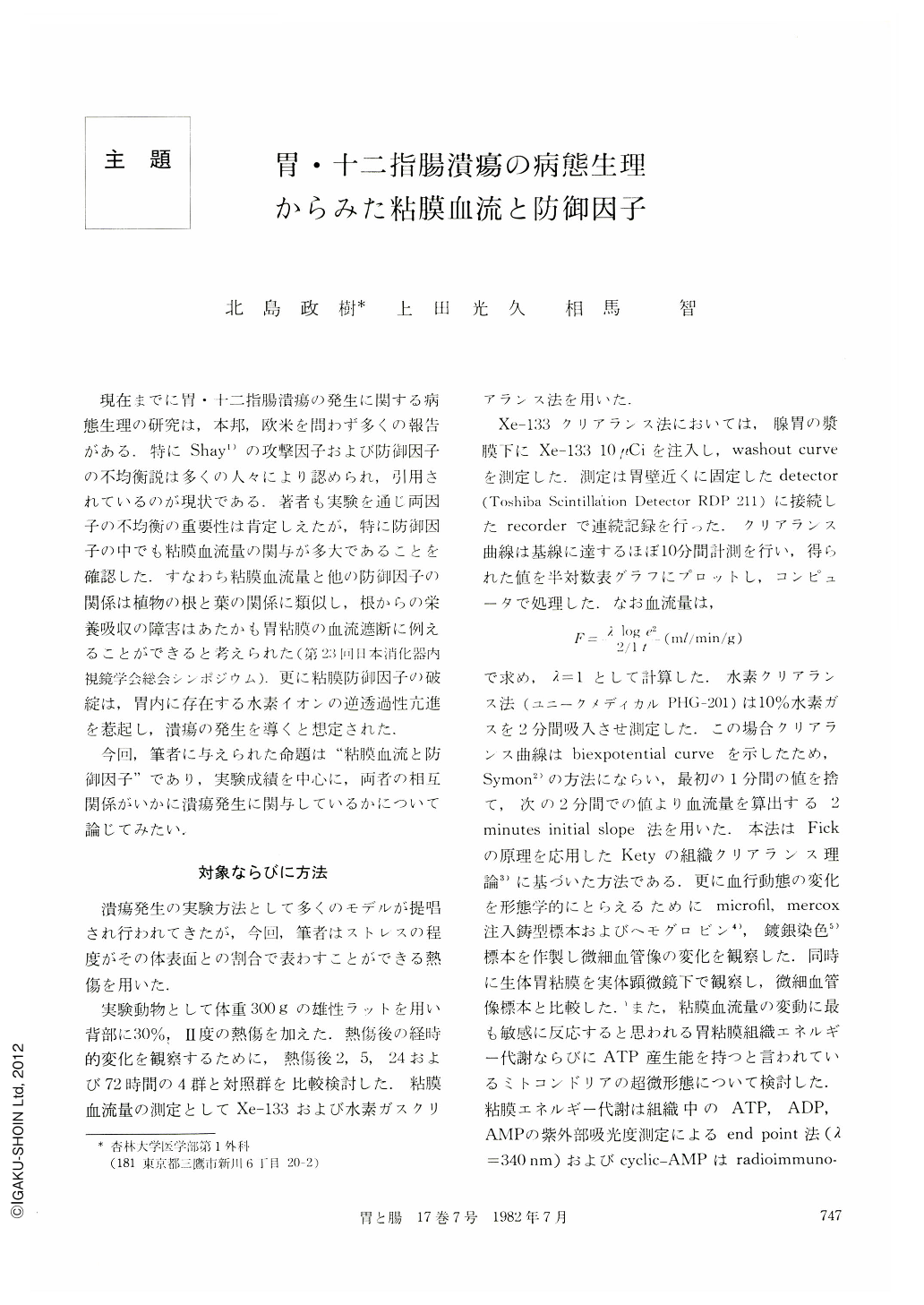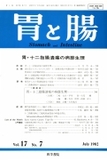Japanese
English
- 有料閲覧
- Abstract 文献概要
- 1ページ目 Look Inside
現在までに胃・十二指腸潰瘍の発生に関する病態生理の研究は,本邦,欧米を問わず多くの報告がある.特にShay1)の攻撃因子および防御因子の不均衡説は多くの人々により認められ,引用されているのが現状である.著者も実験を通じ両因子の不均衡の重要性は肯定しえたが,特に防御因子の中でも粘膜血流量の関与が多大であることを確認した.すなわち粘膜血流量と他の防御因子の関係は植物の根と葉の関係に類似し,根からの栄養吸収の障害はあたかも胃粘膜の血流遮断に例えることができると考えられた(第23回日本消化器内視鏡学会総会シンポジウム).更に粘膜防御因子の破綻は,胃内に存在する水素イオンの逆透過性亢進を惹起し,潰瘍の発生を導くと想定された.
今回,筆者に与えられた命題は“粘膜血流と防御因子”であり,実験成績を中心に,両者の相互関係がいかに潰瘍発生に関与しているかについて論じてみたい.
Several pathogenetic factors of ulcer formation have been proposed including acid hypersecretion and adrenocortical hyperactivity to date. Recently attention has been directed toward the disruption of the defence mechanism of gastroduodenal mucosa. The relationship of gastric microcirculation and other defensive factors, such as mucosal energy metabolism and mucous secretion in anesthetized rats under stress was investigated. Rats subjected to a third degree burn of 30% of the body surface were investigated at times varying from immediately after the burn to 72 hours post burn and compared to sham burned controls. Gastric mucosal blood flow was measured by two clearance methods, Xe-133 and hydrogen gas clearances. Cimetidine's and vagotomy's possible role in regulating gastric mucosal blood flow were also studied. The microvascular structures were verified by the infusion techniques with silicon rubber (MV-122 and MV-117) and Mercox CL resin. Level of adenine nucleotide and Cyclic-AMP in the gastric mucosa were measured by the End-point method and by radioimmunoassay. Energy charge was calculated by using the following formula:
ATP+1/2 ADP
――――――-
ATP+ADP+AMP
The mitochondrial structure in the parietal cell was observed by electron microscope. Concentration of mucoprotein and mucopolysaccharide secreted in the gastric juice was detected by Anthrone, Oricinol and Cysteinesulfate methods. There was a high incidence and severity of mucosal lesions during the first few hours after burn, primarily the fundus. The incidence in animals treated with cimetidine was less than untreated animals, however vagotomized group revealed high incidence of mucosal lesions. Mucosal blood flow measured by different methods revealed the same change in each experimental group. The mucosal flow value detected by hydrogen gas clearance was higher than that by Xe-133 clearance method. Blood flow obtained from Xe-133 clearance in control was 49.1±4.0 ml/min/100 g(Mean±SEM). In the two and five hours after burn, flow decreased significantly about 20% (p<0.05) and 43% (p<0.01) from the control value. Administration of cimetidine prior to burn resulted in a increase of flow (p<0.01), however mucosal blood flow invagotomized group had decreased significantly from that of the untreated group (p<0.05). The normal appearance of the gastric vascular structure coincided with histopathological layers of gastric wall. The diameter of submucosal A-V shunting channels was especially greater at two and five hours postburn as ischemic change and collecting venules and submucosal vein were dilatated as congestion in animals studied at two and five hours. There was a significant decline in the level of ATP and energy change in the animals studied at two and five hours postburn as compared with the control value.
These experimental results supported the impairment of mucosal blood flow considering aerobic energy metabolism. Concentration of mucoprotein and mucopolysaccharide markedly increased during the early period after burn. This phenomenon was considered as a defensive reaction of gastric mucosa toward stress in spite of decrease of mucosal blood flow. Finally, the results of this study demonstrate that the disruption of defence mechanism due to impairment of mucosal flow results in the sequence of events that leads to the ulcer formation, and that cimetidine's role in decreasing stress induced gastric injury may not be due solely to its ability to reduce gastric acid secretion.

Copyright © 1982, Igaku-Shoin Ltd. All rights reserved.


